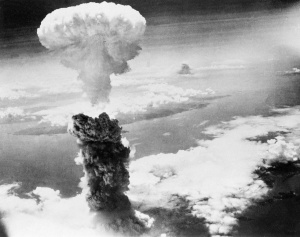Nuclear Deterrence Theory
Nuclear Weapons, usually in the form of bombs or warheads, have long been recognized as a catastrophic force of mass destruction. As an ultra-impactful mean to alter the outcome of wars, captured by the aftermath of the atomic bombings of Hiroshima and Nagasaki in 1945, the technology/information on building Nuclear Weapons had become an essential matter of interest for numerous countries(e.g., the Soviet Union, the United Kingdom, France, China) ever since the end of WWII. Such interest(which eventually led to a series of campaign of Nuclear proliferation among countries) not only attributes to the formidability of Nuclear power, but more importantly the potential stability and order that could have been provided to the globe after wartime[1], as proposed by the American Economist Thomas Schelling’s “Nuclear Deterrence Theory”—the idea that multiple countries simultaneously possessing the ruinous nuke force would actually deter the use of Nuclear Weapons among Nuclear-owned countries, backed up by an explicit mismatch between, intuitively, “a conceivable defense system” and “the speed with which nuclear weapons can be deployed”, according to Schelling[2].
As for now, “Nuclear Deterrence Theory” is adopted by most countries that have acquired the capability of building nuke weapons(i.e., Nine nations have developed the intelligence to create and possess nuclear power), and hence the ethical issues associated with these weapons become increasingly critical and relevant to mankind’s interest(e.g., "Is using Nuclear Weapons permissible under certain circumstances such that intended for eliminating Japanese Fascism and Militarism in 1945?", "Is it ethical to implement nuclear deterrence and threaten to use atomic weapons as a self-defense strategy such as the case of North Korea?").
Contents
History of Nuclear Weapons Development and Nuclear Proliferation
On July 12, 1939(months into WWII)[3], Szilard and Wigner, major contributors to Nuclear technology, visited physicist Albert Einstein on New York's Long Island. It was that night when Albert’s fellow colleagues explained to him about the possibility of atomic bombs, and the concern over the potential that German Fascism may have acquired the same idea, after noticing German nuclear physicist Siegfried Flügge published two influential articles regarding the exploitation of nuclear energy. Szilard and Wigner knew that Einstein held personal relationship with the Belgian Royal Family, whose country was now exposed to the risk of invasion for having the best source of uranium ore at the time, and hence is the suitable person to send the warnings. Einstein eventually signed a letter wrote by Wigner regarding the issue. At Wigner's suggestion, they also prepared a letter for the State Department explaining what they were doing and why, and to see if it had any objections.
This still left the problem of getting government support for Szilard’s uranium research. He was suggested to meet with economist Alexander Sachs, who had access to President Franklin D. Roosevelt. Sachs told Szilard that he had already spoken to the President about uranium and that the prospects for building an atomic bomb were actually remote, according to physicists Enrico Fermi and George B. Pegram’s evaluation. He told Szilard that he would deliver his letter regardless, but suggested that it come from someone more prestigious. For Szilard, Einstein was again the obvious choice for being the influential figure. And it was this time when the president of United States started to comprehend the real nuclear capability.
The following addressed to President Roosevelt on August 2, 1939 warned that:
"In the course of the last four months it has been made probable – through the work of Joliot in France as well as Fermi and Szilard in America – that it may become possible to set up a nuclear chain reaction in a large mass of uranium, by which vast amounts of power and large quantities of new radium-like elements would be generated. Now it appears almost certain that this could be achieved in the immediate future.
This new phenomenon would also lead to the construction of bombs, and it is conceivable – though much less certain – that extremely powerful bombs of a new type may thus be constructed. A single bomb of this type, carried by boat and exploded in a port, might very well destroy the whole port together with some of the surrounding territory. However, such bombs might very well prove to be too heavy for transportation by air.”
It also specifically warned about the potential Nuclear threat from Germany:
"I understand that Germany has actually stopped the sale of uranium from the Czechoslovakian mines which she has taken over. That she should have taken such early action might perhaps be understood on the ground that the son of the German Under-Secretary of State, von Weizsäcker, is attached to the Kaiser-Wilhelm-Institut in Berlin where some of the American work on uranium is now being repeated."
Nuclear Deterrence Theory
Ethical debate of the atomic bombings of Hiroshima and Nagasaki in 1945
Ethical debate of the atomic bombings threat by North Korea
Reference
- ↑ Kenneth Waltz, “The Spread of Nuclear Weapons: More May Better,” Adelphi Papers, Number 171 (London: International Institute for Strategic Studies, 1981) https://www.mtholyoke.edu/acad/intrel/waltz1.htm
- ↑ Schelling, T. C. (1966), "2", The Diplomacy of Violence, New Haven: Yale University Press, pp. 1–34
- ↑ Lanouette, William; Silard, Bela (1992). Genius in the Shadows: A Biography of Leo Szilárd: The Man Behind The Bomb. New York: Charles Scribner's Sons. ISBN 978-0-684-19011-2.
